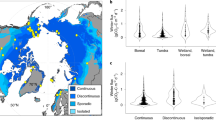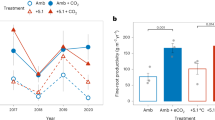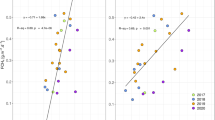Abstract
Compelling evidence has shown that wetland methane emissions are more temperature dependent than carbon dioxide emissions across diverse hydrologic conditions. However, the availability of carbon substrates, which ultimately determines microbial carbon metabolism, has not been adequately accounted for. By combining a global database and a continental-scale experimental study, we showed that differences in the temperature dependence of global wetland methane and carbon dioxide emissions (EM/C) were dependent on soil carbon-to-nitrogen stoichiometry. This can be explained mainly by the positive relationship between soil organic matter decomposability and EM/C. Our study indicates that only 23% of global wetlands will decrease methane relative to carbon dioxide emissions under future warming scenarios when soil organic matter decomposability is considered. Our findings highlight the importance of incorporating soil organic matter biodegradability into model predictions of wetland carbon–climate feedback.
This is a preview of subscription content, access via your institution
Access options
Access Nature and 54 other Nature Portfolio journals
Get Nature+, our best-value online-access subscription
$29.99 / 30 days
cancel any time
Subscribe to this journal
Receive 12 print issues and online access
$259.00 per year
only $21.58 per issue
Buy this article
- Purchase on Springer Link
- Instant access to full article PDF
Prices may be subject to local taxes which are calculated during checkout



Similar content being viewed by others
Data availability
All data needed to evaluate the conclusions are available at Zenodo (https://zenodo.org/records/10044208). The GeoChip data are available in the repository Figshare (https://doi.org/10.6084/m9.figshare.9746303). Source data are provided with this paper.
Code availability
The code used in this study is archived in Supplementary Code 1 and is available at Zenodo (https://zenodo.org/records/10044208).
References
Lal, R. Carbon sequestration. Phil. Trans. R. Soc. B 363, 815–830 (2008).
Nahlik, A. M. & Fennessy, M. S. Carbon storage in US wetlands. Nat. Commun. 7, 13835 (2016).
Chen, H., Xu, X., Fang, C., Li, B. & Nie, M. Differences in the temperature dependence of wetland CO2 and CH4 emissions vary with water table depth. Nat. Clim. Change 11, 766–771 (2021).
IPCC. Climate Change 2022: Mitigation of Climate Change (eds Shukla, P. R. et al.) (Cambbridge Univ. Press, 2022).
Mao, S. et al. Aerobic oxidation of methane significantly reduces global diffusive methane emissions from shallow marine waters. Nat. Commun. 13, 7309 (2022).
Knoblauch, C., Beer, C., Liebner, S., Grigoriev, M. N. & Pfeiffer, E. M. Methane production as key to the greenhouse gas budget of thawing permafrost. Nat. Clim. Change 8, 309–312 (2018).
Segers, R. Methane production and methane consumption: a review of processes underlying wetland methane fluxes. Biogeochemistry 41, 23–51 (1998).
Yvon-Durocher, G. et al. Methane fluxes show consistent temperature dependence across microbial to ecosystem scales. Nature 507, 488–491 (2014).
Zhao, Q. et al. Soil organic carbon content and stock in wetlands with different hydrologic conditions in the Yellow River Delta, China. Ecohydrol. Hydrobiol. 20, 537–547 (2020).
Vicca, S., Janssens, I. A., Flessa, H., Fiedler, S. & Jungkunst, H. F. Temperature dependence of greenhouse gas emissions from three hydromorphic soils at different groundwater levels. Geobiology 7, 465–476 (2009).
Lu, B., Song, L., Zang, S. & Wang, H. Warming promotes soil CO2 and CH4 emissions but decreasing moisture inhibits CH4 emissions in the permafrost peatland of the Great Xing’an Mountains. Sci. Total Environ. 829, 154725 (2022).
Liu, X. et al. Dynamics and controls of CO2 and CH4 emissions in the wetland of a montane permafrost region, northeast China. Atmos. Environ. 122, 454–462 (2015).
Matysek, M. et al. Impact of fertiliser, water table, and warming on celery yield and CO2 and CH4 emissions from fenland agricultural peat. Sci. Total Environ. 667, 179–190 (2019).
Zhao, M. et al. Responses of soil CO2 and CH4 emissions to changing water table level in a coastal wetland. J. Clean. Prod. 269, 122316 (2020).
Li, Y. et al. Oxygen availability regulates the quality of soil dissolved organic matter by mediating microbial metabolism and iron oxidation. Glob. Change Biol. 28, 7410–7427 (2022).
Goncharova, O. Y., Matyshak, G. V., Bobrik, A. A., Timofeeva, M. V. & Sefilyan, A. R. Assessment of the contribution of root and microbial respiration to the total efflux of CO2 from peat soils and Podzols in the north of Western Siberia by the method of component integration. Eurasia. Soil Sci. 52, 206–217 (2019).
Biasi, C., Pitkamaki, A. S., Tavi, N. M., Koponen, H. T. & Martikainen, P. J. An isotope approach based on 13C pulse-chase labelling vs. the root trenching method to separate heterotrophic and autotrophic respiration in cultivated peatlands. Boreal Environ. Res. 17, 184–192 (2012).
Maucieri, C., Barbera, A. C., Vymazal, J. & Borin, M. A review on the main affecting factors of greenhouse gases emission in constructed wetlands. Agric. For. Meteorol. 236, 175–193 (2017).
Mooshammer, M. et al. Adjustment of microbial nitrogen use efficiency to carbon: nitrogen imbalances regulates soil nitrogen cycling. Nat. Commun. 5, 3694 (2014).
Sinsabaugh, R. L., Hill, B. H. & Shah, J. J. F. Ecoenzymatic stoichiometry of microbial organic nutrient acquisition in soil and sediment. Nature 462, 795–798 (2009).
Haddix, M. L. et al. The role of soil characteristics on temperature sensitivity of soil organic matter. Soil Sci. Soc. Am. J. 75, 56–68 (2011).
Chanton, J. P. et al. Radiocarbon evidence for the substrates supporting methane formation within northern Minnesota peatlands. Geochim. Cosmochim. Acta 59, 3663–3668 (1995).
Yuan, F. et al. An integrative model for soil biogeochemistry and methane processes. II: warming and elevated CO2 effects on peatland CH4 emissions. J. Geophys. Res. Biogeosci. 126, 2020JG005963 (2021).
Wang, Q., Liu, S. & Tian, P. Carbon quality and soil microbial property control the latitudinal pattern in temperature sensitivity of soil microbial respiration across Chinese forest ecosystems. Glob. Change Biol. 24, 2841–2849 (2018).
Allen, A. P., Gillooly, J. F. & Brown, J. H. Linking the global carbon cycle to individual metabolism. Func. Ecol. 19, 202–213 (2005).
Enquist, B. J. et al. Scaling metabolism from organisms to ecosystems. Nature 423, 639–642 (2003).
Zuur, A. F., Ieno, E. N., Walker, N. J., Saveliev, A. A. & Smith, G. M. Mixed Effects Models and Extensions in Ecology with R (Springer, 2009).
Yvon-Durocher, G. et al. Reconciling the temperature dependence of respiration across timescales and ecosystem types. Nature 487, 472–476 (2012).
Xiang, D., Wang, G., Tian, J. & Li, W. Global patterns and edaphic-climatic controls of soil carbon decomposition kinetics predicted from incubation experiments. Nat. Commun. 14, 2171 (2023).
Bosatta, E. & Agren, G. I. Soil organic matter quality interpreted thermodynamically. Soil Biol. Biochem. 31, 1889–1891 (1999).
Davidson, E. A. & Janssens, I. A. Temperature sensitivity of soil carbon decomposition and feedbacks to climate change. Nature 440, 165–173 (2006).
Hall, S. J., Ye, C. L., Weintraub, S. R. & Hockaday, W. C. Molecular trade-offs in soil organic carbon composition at continental scale. Nat. Geosci. 13, 687–692 (2020).
Evans, P. N. et al. An evolving view of methane metabolism in the Archaea. Nat. Rev. Microbiol. 17, 219–232 (2019).
Temmink, R. J. M. et al. Recovering wetland biogeomorphic feedbacks to restore the world’s biotic carbon hotspots. Science 376, eabn1479 (2022).
Wang, Z. G. et al. Human-induced erosion has offset one-third of carbon emissions from land cover change. Nat. Clim. Change 7, 345–349 (2017).
Liu, L. et al. Water table drawdown reshapes soil physicochemical characteristics in Zoige peatlands. Catena 170, 119–128 (2018).
Leifeld, J., Klein, K. & Wust-Galley, C. Soil organic matter stoichiometry as indicator for peatland degradation. Sci. Rep. 10, 7634 (2020).
Leifeld, J. & Menichetti, L. The underappreciated potential of peatlands in global climate change mitigation strategies. Nat. Commun. 9, 1071 (2018).
Evans, C. D. et al. Overriding water table control on managed peatland greenhouse gas emissions. Nature 593, 548–552 (2021).
Hoffland, E., Kuyper, T. W., Comans, R. N. J. & Creamer, R. E. Eco-functionality of organic matter in soils. Plant Soil https://doi.org/10.1007/s11104-020-04651-9 (2020).
Billings, S. A. & Ballantyne, F. How interactions between microbial resource demands, soil organic matter stoichiometry, and substrate reactivity determine the direction and magnitude of soil respiratory responses to warming. Glob. Change Biol. 19, 90–102 (2013).
Cotrufo, M. F. et al. Formation of soil organic matter via biochemical and physical pathways of litter mass loss. Nat. Geosci. 8, 776–779 (2015).
Koven, C. D., Lawrence, D. M. & Riley, W. J. Permafrost carbon-climate feedback is sensitive to deep soil carbon decomposability but not deep soil nitrogen dynamics. Proc. Natl Acad. Sci. USA 112, 3752–3757 (2015).
Noyce, G. L., Smith, A. J., Kirwan, M. L., Rich, R. L. & Megonigal, J. P. Oxygen priming induced by elevated CO2 reduces carbon accumulation and methane emissions in coastal wetlands. Nat. Geosci. 16, 63–68 (2023).
Leroy, F. et al. Vegetation composition controls temperature sensitivity of CO2 and CH4 emissions and DOC concentration in peatlands. Soil Biol. Biochem. 107, 164–167 (2017).
Fey, A. & Conrad, R. Effect of temperature on carbon and electron flow and on the archaeal community in methanogenic rice field soil. Appl. Environ. Microbiol. 66, 4790–4797 (2000).
Bradford, M. A. et al. Thermal adaptation of soil microbial respiration to elevated temperature. Ecol. Lett. 11, 1316–1327 (2008).
Matthews, G. V. T. The Ramsar Convention on Wetlands: Its History and Development (Ramsar Convention Bureau, 1993).
Shangguan, W., Dai, Y. J., Duan, Q. Y., Liu, B. Y. & Yuan, H. A global soil data set for Earth system modeling. J. Adv. Model. Earth Syst. 6, 249–263 (2014).
Fan, Y., Li, H. & Miguez-Macho, G. Global patterns of groundwater table depth. Science 339, 940–943 (2013).
Sun, Y. et al. A global meta-analysis on the responses of C and N concentrations to warming in terrestrial ecosystems. Catena 208, 105762 (2022).
Liu, Y., Jiang, M., Lu, X., Lou, Y. & Liu, B. Carbon, nitrogen and phosphorus contents of wetland soils in relation to environment factors in Northeast China. Wetlands 37, 153–161 (2017).
R Core Team. R: A Language and Environment for Statistical Computing (Version 3.6.3) (R Foundation for Statistical Computing, 2020); http://www.r-project.org
Payton, M. E., Greenstone, M. H. & Schenker, N. Overlapping confidence intervals or standard error intervals: what do they mean in terms of statistical significance? J. Insect Sci. 3, 34 (2003).
Zhong, Z. et al. Adaptive pathways of soil microorganisms to stoichiometric imbalances regulate microbial respiration following afforestation in the Loess Plateau, China. Soil Biol. Biochem. 151, 108048 (2020).
Gelinas, Y., Baldock, J. A. & Hedges, J. I. Demineralization of marine and freshwater sediments for CP/MAS 13C NMR analysis. Org. Geochem. 32, 677–693 (2001).
Liang, Y. et al. Development of a common oligonucleotide reference standard for microarray data normalization and comparison across different microbial communities. Appl. Environ. Microbiol. 76, 1088–1094 (2010).
Shi, Z. et al. Functional gene array-based ultrasensitive and quantitative detection of microbial populations in complex communities. mSystems 4, e00296-19 (2019).
Acknowledgements
The authors received funding from Strategic Priority Research Program of the Chinese Academy of Sciences (XDA28030102 to Y.L.), National Natural Scientific Foundation of China (92251305 to M.N., 41622104 to Y.L.), Innovation Program of the Institute of Soil Science (ISSASIP2201 to Y.L.) and Youth Innovation Promotion Association of the Chinese Academy of Sciences (2016284 to Y.L.).
Author information
Authors and Affiliations
Contributions
Y.L., H.H., M.N., J.C. and J. Zhang conceptualized the research project. H.H., M.N., M.D.-B., H.N., F.Z., J. Zhou and Y.L. developed the methodology. H.H., J.C., M.D.-B., H.N., W.H., X.S., H.L. and Y.L. were responsible for data collection and analysis. Y.L., J. Zhang, X.C. and B.S. provided supervision throughout the project. Y.L., H.H., J.C., M.N., D.H. and T.W.C. wrote the original draft. H.H., J.C., F.Z., M.N., D.H., H.L., M.D.-B., H.N., W.H., J. Zhou, X.S., X.C., B.S., J. Zhang, T.W.C. and Y.L. contributed to the review and editing process.
Corresponding author
Ethics declarations
Competing interests
The authors declare no competing interests.
Peer review
Peer review information
Nature Geoscience thanks the anonymous reviewers for their contribution to the peer review of this work. Primary Handling Editor: Xujia Jiang, in collaboration with the Nature Geoscience team.
Additional information
Publisher’s note Springer Nature remains neutral with regard to jurisdictional claims in published maps and institutional affiliations.
Extended data
Extended Data Fig. 1 Geographical distribution of the sites in the global database (a) and frequency distribution of carbon emission observations at the site level (b).
In panel a, there might be overlaps among these sites. The size of the circle indicates the number of observations.
Extended Data Fig. 2 Temperature dependence of CO2 (EC) and CH4 (EM) emissions on a global scale.
a, The temperature dependence of the greenhouse gas (GHG) emissions was characterized using the linear mixed effects (LME) model after fitting the Boltzmann-Arrhenius function to the data of the GHG emissions and the standardized temperature (Methods). b, The dashed lines show the average.
Extended Data Fig. 3 Temperature dependence of the CH4:CO2 emission ratio (EM:C) at different water table depth intervals and soil C:N intervals.
The temperature dependence was characterized using the linear mixed effects (LME) model after fitting the Boltzmann-Arrhenius function to the data of the CH4:CO2 emission ratio and the standardized temperature (Methods). Different soil C:N intervals were classified using the results of the sliding window-LME model. Different water table depth intervals are classified according to the results of Chen et al. (ref. 3, 10.1038/s41558-021-01108-4).
Extended Data Fig. 4 Geographical distribution of the sites (a) and sampling strategy (b) in the incubation experiment.
Samples were taken from 39 paddy soil sites located in 13 regions of China. The numbers in parentheses represent the mean annual air temperature (°C) in the sampling region. At each site, 11 nested samples were collected at distances of 1, 6, 16, 36 and 76 m. CC = Changchun; CT = Changting; FQ = Fengqiu; HK = Haikou; HL = Hailun; HY = Hengyang; JO = Jian’ou; LA = Lin’an; OM = organic matter; QX = Qingxin; QZ = Quzhou; SY = Shenyang; TN = total nitrogen; YY = Yuanyang; ZX = Zixi.
Extended Data Fig. 5 Linear regression analysis between the temperature dependences of CH4 emissions (EM) and CO2 emissions (EC) with soil organic matter decomposability in incubation experiments.
The Ea of SOM decomposition represents the apparent activation energy of soil organic matter decomposition. DOC, dissolved organic carbon; SOC, soil organic carbon. Error bands are 95% confidence intervals of the regression lines.
Extended Data Fig. 6 The distribution of the difference in the temperature dependence of CH4 and CO2 emissions (EM:C), soil C:N, water table depth, and mean annual temperature in different climate zones.
a, EM:C distribution in different climate zones. The climatic zones are classified by the Köppen climate classification. A, B, C, D, and E represent tropical, arid, temperate, cold, and polar climates, respectively. Centre lines are medians, and diamonds represent the averages. Box limits are upper and lower quartiles. whiskers are 1.5× the interquartile ranges. The numbers in brackets represent wetland area (km2). b, Relative area of wetlands with positive and negative EM:C values. C, The distribution of soil, water table depth, and mean annual temperature of wetlands in different climate zones. The red dotted lines are the global mean values.
Supplementary information
Supplementary Information
Supplementary Figs. 1–8 and Tables 1–4.
Supplementary Data 1
Including (1) the dataset of meta-analysis, (2) the detail information of the soil samples and (3) the exact value of each point in the global map.
Supplementary Code 1
Including code for the machine-learning and the linear mixed-effects models.
Source data
Source Data Fig. 1
Statistical source data.
Source Data Fig. 2
Statistical source data.
Source Data Fig. 3
Statistical source data.
Source Data Extended Data Fig. 1
Statistical source data.
Source Data Extended Data Fig. 2
Statistical source data.
Source Data Extended Data Fig. 3
Statistical source data.
Source Data Extended Data Fig. 4
Statistical source data.
Source Data Extended Data Fig. 5
Statistical source data.
Source Data Extended Data Fig. 6
Statistical source data.
Rights and permissions
Springer Nature or its licensor (e.g. a society or other partner) holds exclusive rights to this article under a publishing agreement with the author(s) or other rightsholder(s); author self-archiving of the accepted manuscript version of this article is solely governed by the terms of such publishing agreement and applicable law.
About this article
Cite this article
Hu, H., Chen, J., Zhou, F. et al. Relative increases in CH4 and CO2 emissions from wetlands under global warming dependent on soil carbon substrates. Nat. Geosci. 17, 26–31 (2024). https://doi.org/10.1038/s41561-023-01345-6
Received:
Accepted:
Published:
Issue Date:
DOI: https://doi.org/10.1038/s41561-023-01345-6



